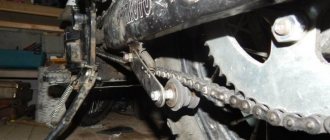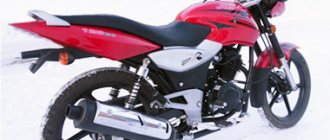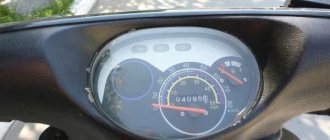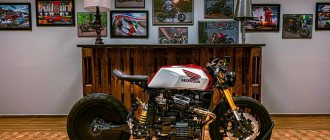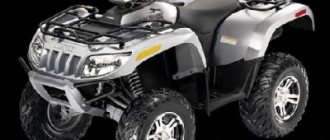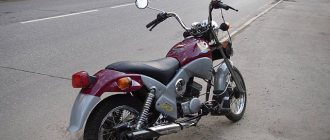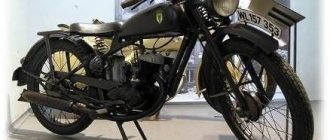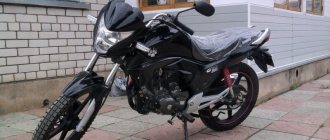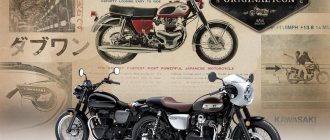Off-road motorcycle KTM 200 EXC 2008
New release of the KTM two-stroke “SUV” with an engine capacity of 200 cc. The new KTM 200 EXC is surprisingly tall and has great torque - ideal for technical riding. An excellent combination of maneuverability and power.
In general, KTM beat out all other manufacturers with its 2008 release, releasing the 200EXC and 300EXC motocross motorcycles a month before the appearance of other models from competitors. The KTM 200 EXC wasn't widely discussed and was overshadowed by the 300 EXC - most of the talk was about the bigger bike.
The 2008 200 EXC features a new frame on the chassis of the 250 SXF. These are pipes of a different profile with double flat beams. Moreover, they are made of chrome-molybdenum steel, i.e. the quality is excellent. The main frame also has a new subframe, and the swing arm and shock absorber are taken from a racing bike. All these changes are said to improve management. This is debatable - the first feeling is that last year’s option was just the most optimal. The new KTM 200 EXC has become very light, and this of course affects the handling, but practice will show in which direction.
It's a fact that the 200 EXC is the simplest bike you can get in this class. The kick starter is well positioned and requires almost no effort to turn it fully. The motorcycle always comes to life “with half a turn”. When you sit on it, it seems small. But this is a deceptive feeling - when the 200 and 300 models are side by side, they cannot be distinguished from each other unless you look at the stickers. This "compact" feeling is probably due to the weight distribution... there are simply no other options available. Although the KTM 200 EXC is narrow, it is very tall - short people will have to reach to the ground.
The suspension of the KTM 200 EXC is made on a WP fork with a length of 48mm. It's not a two-volume MX fork, but it does have a new preload adjuster. The suspension is optimally tuned by the manufacturer - the adjustment levers may not be useful. At the rear there is the same shock absorber as on MX motorcycles, turned backwards to imitate a sports suspension. The front vibration that was present in the previous model has disappeared, the motorcycle handles quickly and accurately...
The brakes on the KTM 200 EXC... they are amazing! You need to hold on tight when you try to brake the KTM 200 EXC because... the speed is extinguished very quickly - this is braking with one finger. Brembo brakes are probably the most efficient in the industry. They used to be so-so, but over the last few years all Brembo brakes have been at least impressive.
The KTM 200 EXC motor surprised me the most. In general, the torque of the baby KTM has been amazing before, but this year it is simply amazing. The torque at low speeds is simply more than a 200 cc motorcycle has the right to develop. It certainly can't completely replace a 450cc motorcycle, but it's nonetheless powerful and it's power that many people can afford. The engine provides a smooth increase in power when the gear is correctly selected. The KTM 200 EXC rolls effortlessly up hills that are supposed to be covered only by frantically shifting gears and revving the engine. Compared to the strong impression at low revs, the midrange is not particularly impressive - it just is there and that's all. The engine works calmly and predictably; such work does not evoke any reproaches or admiration. At high revs the engine is what you'd expect from a small-bore two-stroke, and the lightweight KTM 200 EXC simply shoots forward. You have to be prepared to play with the stick because the six-speed gearbox is excellent, but at 7 km/h you're already looking for seventh gear.
Actually, the KTM 200 EXC is not a motorcycle for open racing, and this becomes clear after riding the 300. If you do open country drag racing, you will buy the 300 EXC all the time. And if you are a completely avid racer, then you will generally think about something more serious. And the 200 EXC is, in fact, a fairly ordinary motorcycle in its class with 5 or 6 gears. After driving it for 5 kilometers, you can’t feel your fingers or toes. And this is not surprising, and that’s not the point.
The bottom line is that the KTM 200 EXC has a small engine with fairly modest power, but due to its light weight and excellent handling, it is really fast in the right conditions. Very few bikes will be able to keep up with it when the trails really get tough. It thrives on the toughest parts of the track, when the big bikes are unable to use their full power. It seems to laugh at its larger brothers, flying from one turn to another as they chug and fight their way through the trees.
Overall the 200EXC is a cool bike. He is fast, but not crazy fast. He is agile, but at the same time understands the slightest movements of the rider. An excellent suspension inspires confidence.
2008 KTM 200 EXC Motorcycle Specifications.
- Engine – single cylinder, 2 stroke
- Working volume – 193 cm3
- Power supply system – carburetor Keihin PWK 36 S AG
- Starting the engine - kick starter
- Cooling system – liquid
- Fuel tank volume l – 9.5
- Number of gears – 6
- Drive type – chain
- Front wheel – 90/90-21″
- Rear wheel – 120/90-18″
- Front suspension – WP USD Ø 48 mm (1.89″)
- Front suspension travel – 300.00
- Rear suspension – WP PDS shock absorber
- Rear suspension travel mm – 335.00
- Front brake - disc
- Rear brake - disc
- Wheelbase – 1471 ± 10 mm
- Seat height – 925 mm
- Ground clearance – 390 mm
- Dry weight – 97 kg
Estimated price of the KTM 200 EXC motorcycle
Irbis VR-1
Irbis VR-1 – photo 1
Irbis VR-1 – photo 2
Irbis VR-1 – photo 3
Irbis VR-1 – photo 4
Irbis VR-1 – photo 5
Technical characteristics of Irbis VR-1
| Type | Motorbike |
| Class | Motorcycle road |
| Length, mm | 2000 |
| Width, mm | 740 |
| Height, mm | 1050 |
| Seat height, mm | – |
| Guarantee | 12 months or 3 thousand km |
| Country of assembly | Russia |
Modifications of Irbis VR-1
Irbis VR-1 200
| Maximum speed, km/h | 95 |
| Acceleration time to 100 km/h, sec | – |
| Engine | Gasoline carburetor |
| Number of cylinders / arrangement | 1 |
| Number of bars | 4 |
| Working volume, cm 3 | 197 |
| Power, hp / rpm | 14.4/7500 |
| Torque, N m / rpm | 13.5/6500 |
| Fuel consumption, l per 100 km | 2.3 |
| Curb weight, kg | 125 |
| Gearbox type | Mechanical |
| Cooling system | Air |
| Show all characteristics | |
Odnoklassniki Irbis VR-1 price
Unfortunately, this model has no classmates.
Reviews from Irbis VR-1 owners
IRBIS VR-1, 2013
For the money, the motorcycle is gorgeous, stronger than the Voskhod, but weaker than the Jupiter. Its advantages: good acceleration, pleasant sound, appearance, I don’t know about reliability - I rode 1200 km. Of the minuses: tires can be treated by replacing them, I installed Dunlop, replaced the carburetor with a good Japanese one with slightly larger jets. Valves, many people struggle with them, but mine were 0.03 and 0.06 from the factory, so I’m happy and satisfied. The light of the IRBIS VR-1 is too weak, it can be treated by installing xenon, but not very powerful, 35W is enough, and without a lens, otherwise we interfere with the road, some bolts are unscrewed, it can be treated immediately after purchase. We buy blue thread fixing, not red, because... then we can’t unscrew the red one without a hair dryer, and we unscrew all the bolts that are needed and pull them through with the fixing. We pay attention to the engine mounting to reduce vibration by installing rubber gaskets. And, most importantly, test it properly, don’t drive it more than 40, and then the IRBIS VR-1 will reward you with a long service life. Good luck on the roads.
Advantages
: vigorous for acceleration. Pleasant exhaust sound. Appearance is good.
Flaws
: standard tires. The light is weak.
IRBIS VR-1, 2014
I drove 1000 km on IRBIS VR-1. There are problems: the revs jump as they please. It starts only with gas (the choke does not help), it may stall at idle. I turned it off and went to drink coffee, I came, turned on the ignition, and there were 0 emotions from it, the instrument panel did not light up, it turned out that the ignition wire was coming off. The seat won't open, something is stuck there. In short, the entire IRBIS VR-1 needs to be adjusted, adjusted, and shown to some specialist.
Advantages
: drives well.
Flaws
: Requires constant attention.
IRBIS VR-1, 2012
I've owned a motorcycle for 3 years, only good reviews. At the end of last season I had an accident (without injuries, not my fault), the front wing and speedometer burst a little (cured), but the most offensive thing is that the wheel moved a little (the brake disc is fine), straightened it, everything is fine (for a new one) was ready for the season). This year my brother gave me a Ninzdu 400 2011. At first I forgot about the IRBIS VR-1, but a week ago I punctured the rear wheel on it and remembered about the “old friend” and decided to take it for a ride. At first everything was fine, literally 500 meters before the first turn I braked (I always hold down both the front and rear brakes), started off and heard a sound, something was scratching in the front wheel, I stopped and looked - everything seemed fine, I drove on, the sound continued, I turned around , went home. After a thorough inspection, I noticed that the brake fluid level had decreased (I never added it, there were no leaks, I check such things before every trip). I unscrewed the brake - everything looked fine, I shook it, tightened all the bolts, and put it back. I decided to take another ride, as soon as I started driving more than 20 km/h, the sound began to increase. I decided to press the front brake all the way, but as a result the sound only intensified and the fluid level decreased a little more. In short, China is China.
Advantages
: appearance. Pleasant to drive.
IRBIS VR-1, 2013
So, my opinion about the IRBIS VR-1 (I’ll say right away that this is not my first motorcycle, and was purchased spontaneously). The seating position is comfortable, but not for long trips; after fifty kilometers you begin to fidget in the saddle at the same point where you were looking for adventure. Brakes: the front brakes as it should, even though it is a 1-piston machine with one disc. The rear is a drum type, only for slowing down and maneuvering at low speeds. The rider's position is somewhere between a classic and a naked, in general, neither here nor there. I was pleased with the consumption: about 7 liters per two hundred (break-in and half a stick of gas). The fork does the job, but the rear shocks definitely don't. It would be more correct to put them on a motorcycle weighing about 200 kg. On the IRBIS VR-1 they really kick back on every bump and hole, after 30 km they started to rise up on uneven surfaces, like on an enduro when driving over large obstacles. Gearbox: when the speed is reduced, sometimes the lower gears do not want to “stick” like 3-2-1, this can be corrected by “snatching” in the gear in which the gearbox shift foot is placed, and there is no talk of any “circular gearbox”, as the manufacturers say . Conclusions: an excellent small-capacity motorcycle for the city (village), but not suitable for long-distance travel. Izhey “does” all the brands I know without any doubt, and at half power it fully fulfills its 100 km per hour at 6000 rpm.
Advantages
: frisky. Universal. Easy to manage. Easy to repair.
Flaws
: Rear shock absorbers are too hard.
It’s been a while since I’ve made a post about my conic. I’ll probably start with the last season - 2022. Despite the very rainy summer (last year - 2017), the motor was used to its fullest. He drove me to/from work (almost) every day—almost 70 km; I was working outside the city at the time. On weekends I rode in different directions and mostly on asphalt.
There was even a mini-long drive - 700 km back and forth.
It drove properly and didn't bother me with breakdowns at all. He just drove and drove. I made do with simple maintenance - changed the chain, changed the oil. The chain is the simplest - 428 produced in Daugavpils. Since the original chain on Zephyr is very long - 137 links - you have to buy two chains, divide one into pieces and splice them together with two locks. I change the oil once every 2000. I use regular mineral water 15W30, 15W40. The engine doesn't complain. Somewhere at the beginning of summer, I got into a small accident - I was driving to work as usual, got lost and almost caught up with the Kia Rio. In the end, he almost dodged, but still landed a glancing blow on the Korean’s rear bumper with his left foot. They parted ways with the motorist peacefully, because he did not cause any visible damage to his car, but he did cause damage to his left foot. Apparently something was broken in her. The leg was swollen, painful and absolutely did not fit into the shoe. When it had healed a little, I welded the “heel” part to the gear shift foot so that you could shift “up” with your heel.
So I drove until it healed. Then I removed this part with a grinder. Then they gave me an 18″ rim from IZH and I independently re-spoke the rear wheel onto this rim.
I did this for the first time after watching enough videos on YouTube. I finished it in about 3 hours. I put on an almost new donated Kenda k270 Dual sport tire. “Universal” rubber. It doesn’t buzz on the asphalt like a pure “cross bike” and can do something on dirt roads. He really doesn’t like wet asphalt - it’s like a cow on ice. I went with my endurist friends on a short ride through the forest and everything would have been fine. if it weren't for the rain. The stock front tires don't hold up on wet ground at all. I fell 10 times, broke off the case, bent the steering wheel, and got a dent on the muffler. Everything else passed the test. I installed an LED bicycle light - DRL - on the front fender under the headlight. To make it shine brighter, I made a new 3.2V driver for it. I also made a 12V - 5V 3A converter, connected a microUSB wire from it to the steering wheel and installed a holder for the navigator. Once the rear shock absorber disassembled itself - its cast eye was unscrewed. I removed, reassembled, and welded the eyelet so that it would no longer unscrew. I installed the shock absorber “as an adult” - with the rod down. The starter relay began to act up - I “temporarily” installed the GAZel starter relay at 60A, and I drove around with it. I don’t remember more improvements, repairs and adventures. As a result, by the end of the season, about 7,000 km had been added to his odometer. He spent the winter in the garage of friends in the village.
I just removed the battery. Didn't do anything else.
Season 2018
Mileage at the beginning of the 2022 season is 13,250 km.
In March 2022, I bought a 21″ rim from Kayo and re-spoke the front wheel onto this rim.
The stock knitting needles turned out to be a little short, so I could only knit them in a “one cross”. I thought, if I can’t stand it, I’ll buy long knitting needles. But no. Pah-pah-pah, the wheel is holding up well. He also wore a donated Kenda K270. I bought a new RED ENERGY 7Ah 12V gel battery with indicator (1,700 rubles). The battery is crap. The charge holds the same as the old one - about 1 week. The alarm is slowly eating up electricity. After wintering, the rear brake suddenly disappeared - I changed the pads, pumped them, but still something was wrong. It takes too much effort. Last season the brakes were much easier. I bent a new steering wheel from stainless steel myself. I polished it, welded the jumper, and poured polyester resin inside for extra rigidity. There was only one fall - in the parking lot. The battery died, but it wouldn’t start from the kick-starter. The steering wheel survived the fall onto the gravel without any problems. Last week there was a small problem - the chain broke, which I “successfully” wanted to change since the beginning of the season. Well, I pushed my motorcycle 4 kilometers through the city at night into science. Luckily the weather was great. The next day I went and bought a couple of new “Kovrov” chains (2 x 450 rubles) and assembled the necessary ones from them. The result was 130 links. The rear brake sensor has failed. Ours is hydraulic. While there is a parcel from Bryansk with a new sensor (200 rubles), I welded the bracket and hooked up an ordinary Zhiguli “frog”. The rubber chain slider is completely worn out. I looked at the new ones in the store, was a little shocked by the price for a piece of shitty rubber, and screwed a piece of car tire tread onto the pendulum. Works fine. I also ordered a 14-tooth drive sprocket there (100 rubles). with a 15-tooth gear there is little traction (41:15=2.73), with a 13-tooth gear there is little speed (41:13=3.15). I replaced the GAZel starter relay (it began to stick or not work at all) with a normal one (250 rubles). The motorcycle season continues, I ride a motorcycle every day. This year, of course, it’s harder for him - now he often takes me as a passenger. The rear shock absorber has a hard time. The rear spring has a “progressive” coiling, its travel is catastrophically small and often with the second number the rear suspension sits on the bump stop. I need to do something, I don’t know what yet. A 200 cc engine and 13 horses is not enough. The maximum speed according to GPS is as much as 108.7 km/h (according to the speedometer 125). The acceleration in the first hundred meters is brisk - I quite successfully get away from the cars starting with me at the traffic light, but then everything is sad - overtaking trucks is painful. So I’m thinking of doing a swap - buying a more powerful motor and using it instead of the standard one. Or a used Japanese one with 250-400 cubic meters or a similar volume of a brand new Chinese one. I want to do something with the headlight. The H4 55/60 bulb does not shine very well, but it consumes a decent amount. I measured the voltage on the go - only 12.3 - 12.5 volts. Not enough to charge the battery. The generator is weak. With a bike light 13.3-13.9 is already something. I’m thinking of buying an LED one from Ali and putting it in the iron housing of the Izhevsk headlight. You should eat less and shine brighter. Well, that’s all the news for now, I’m rolling the season. Good luck to everyone, no breakdowns and no accidents!
UPD . Yesterday I went to the post office to pick up a parcel from Bryansk. I received it and a “letter of happiness” to boot. For the first time I fell for the "gyrfalcon", before they did not recognize the license plate number in our city, but now apparently they have learned.
Casio Exilim EX-ZR200
Bortnikov Paul, 01/03/2013
Advantages: All the advantages are inherent, which have already been described more than once in both this model and the ZR100 - speed, wide-angle lens, clear photos, capacious battery (1800 mAh), etc. I will concentrate on the disadvantages. There is some mode in which the zoom can be up to 25 (maybe 12.5 and 18.8) and this is WITHOUT taking into account digital zoom (i.e. after these numbers there is also the possibility of digital zoom).
Disadvantages: 1. Still, the noise of the matrix is present from ISO800 and higher, especially if you shoot in a dimly lit room and without flash. It can be seen if you enlarge the photo on the screen as much as possible when viewing it (i.e. almost under a microscope), it looks like scattered metal shavings. 2. In the corners, the clarity “floats” a little, especially in the top left and bottom right - I saw it on all models, I especially paid attention, again it is visible when shooting test tables at maximum photo magnification. 3. Your own USB “connector”. For some reason, the adapter is such that you can only charge via a USB cord, but you cannot insert the battery into it. 4. It was not possible to charge using any “Chinese” standard USB charger - the light that shows the charge on the phone does not light up. It’s strange, because all other devices are charged from these chargers (standard output - 5V, 500-1000mAh). They charge from the computer. 5. When shooting with flash in a room illuminated by poop lamps, the BB turns into a “golden hue”. I couldn’t win - I tried it with all BB modes, including manual. I won’t say that it’s annoying or ugly, but it’s strange. 6. There is no 1280x720 video mode, i.e. 1980x1080, and then 640x480. 7. There is no stabilizer - whether it’s on or off, I didn’t notice any difference. If there is “stir”, then it is also present with the stabilizer, specially imitated. Although this is not as noticeable on a computer screen as on a camera screen. And on the computer the colors are not as bright as on the camera screen. 8. When shooting video, you can use the zoom, but although it buzzes quietly, when recording in complete silence, the buzz can be heard in the recording.
Comment: I have been a fan of Casio for 10 years now, since its first “masterpiece” Casio QV-R3, then EX-P600. So, I compared it with my “old man” Casio EX-P600, which I also considered “impeccable” and which is rated quite well in terms of quality among digital point-and-shoot cameras. What can I say, heaven and earth. The P600 at ISO 400 has all the photos in noise - blue-red-green dots that are visible even on its 2.7″ screen without zooming in, but at ISO 3200 there are small black pins if you zoom in on the photo at maximum when viewing it on a 3″ screen. Well, and the wide format of the lens - the photo contains twice as much information (the view being shot).
